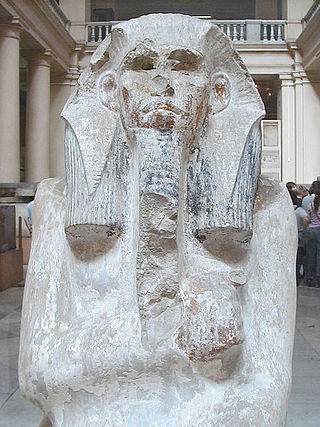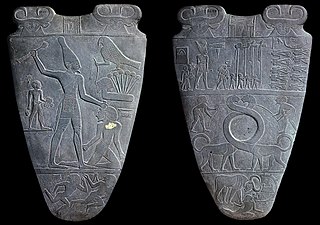
Anubis, also known as Inpu, Inpw, Jnpw, or Anpu in Ancient Egyptian, is the god of funerary rites, protector of graves, and guide to the underworld, in ancient Egyptian religion, usually depicted as a canine or a man with a canine head.
In Egyptian history, the Upper and Lower Egypt period was the final stage of prehistoric Egypt and directly preceded the unification of the realm. The conception of Egypt as the Two Lands was an example of the dualism in ancient Egyptian culture and frequently appeared in texts and imagery, including in the titles of Egyptian pharaohs.

Djoser was an ancient Egyptian pharaoh of the 3rd Dynasty during the Old Kingdom, and was the founder of that epoch. He is also known by his Hellenized names Tosorthros and Sesorthos. He was the son of King Khasekhemwy and Queen Nimaathap, but whether he was also the direct successor to their throne is unclear. Most Ramesside king lists identify a king named Nebka as preceding him, but there are difficulties in connecting that name with contemporary Horus names, so some Egyptologists question the received throne sequence. Djoser is known for his step pyramid, which is the earliest colossal stone building in ancient Egypt.

Narmer was an ancient Egyptian pharaoh of the Early Dynastic Period, whose reign began at a date estimated to fall in the range 3273–2987 BC. He was the successor to the Protodynastic king Ka. Many scholars consider him the unifier of Egypt and founder of the First Dynasty, and in turn the first king of a unified Egypt. He also had a prominently noticeable presence in Canaan, compared to his predecessors and successors. Neithhotep is thought to be his queen consort or his daughter.

The Narmer Palette, also known as the Great Hierakonpolis Palette or the Palette of Narmer, is a significant Egyptian archaeological find, dating from about the 31st century BC, belonging, at least nominally, to the category of cosmetic palettes. It contains some of the earliest hieroglyphic inscriptions ever found. The tablet is thought by some to depict the unification of Upper and Lower Egypt under the king Narmer. Along with the Scorpion Macehead and the Narmer Maceheads, also found together in the main deposit at Nekhen, the Narmer Palette provides one of the earliest known depictions of an Egyptian king. On one side, the king is depicted with the bulbed White Crown of Upper (southern) Egypt, and the other side depicts the king wearing the level Red Crown of Lower (northern) Egypt, which also makes it the earliest known example of a king wearing both types of headdress. The Palette shows many of the classic conventions of Ancient Egyptian art, which must already have been formalized by the time of the Palette's creation. The Egyptologist Bob Brier has referred to the Narmer Palette as "the first historical document in the world".
The Early Dynastic Period, also known as Archaic Period or the Thinite Period, is the era of ancient Egypt that immediately follows the unification of Upper and Lower Egypt in c. 3150 BC. It is generally taken to include the First Dynasty and the Second Dynasty, lasting from the end of the archaeological culture of Naqada III until c. 2686 BC, or the beginning of the Old Kingdom. With the First Dynasty, the Egyptian capital moved from Thinis to Memphis, with the unified land being ruled by an Egyptian god-king. In the south, Abydos remained the major centre of ancient Egyptian religion; the hallmarks of ancient Egyptian civilization, such as Egyptian art, Egyptian architecture, and many aspects of Egyptian religion, took shape during the Early Dynastic Period.

Hor-Aha is considered the second pharaoh of the First Dynasty of Egypt by some Egyptologists, while others consider him the first one and corresponding to Menes. He lived around the 31st century BC and is thought to have had a long reign.

Ancient Egyptian art refers to art produced in ancient Egypt between the 6th millennium BC and the 4th century AD, spanning from Prehistoric Egypt until the Christianization of Roman Egypt. It includes paintings, sculptures, drawings on papyrus, faience, jewelry, ivories, architecture, and other art media. It was a conservative tradition whose style changed very little over time. Much of the surviving examples comes from tombs and monuments, giving insight into the ancient Egyptian afterlife beliefs.

Scorpion II, also known as King Scorpion, was a ruler during the Protodynastic Period of Upper Egypt.

Deshret was the Red Crown of Lower Egypt. When combined with the Hedjet of Upper Egypt, it forms the Pschent, in ancient Egyptian called the sekhemti.
In ancient Egyptian hieroglyphs, the hand symbol represented the phoneme /d/, and was also used as a determinative for actions performed as if with the hands.
The ancient Egyptian Game piece (hieroglyph), also a Token, or the general term for any gaming-gambling piece, Draughtsman is an ancient hieroglyph. Gaming pieces were certainly required in predynastic times, as the cultural creation of games and entertainment has a long history in most cultures. An ivory-piece lion is known from the Old Kingdom of ancient Egypt; the set contains three lions, and three dog tokens of ivory.
The Throw stick hieroglyph of ancient Egypt is an old hieroglyph that dates from the Predynastic Period; it is from the assemblage of hieroglyphs used on the ornamental, or ceremonial cosmetic palettes. It is used on the palettes both as a throwing-stick weapon in the animal hunt being portrayed-(the Hunters Palette), as well as on certain palettes, as a determinative referring to a "foreigner", or "foreign territory".

The Battlefield Palette may be the earliest battle scene representation of the dozen or more ceremonial or ornamental cosmetic palettes of ancient Egypt. Along with the others in this series of palettes, including the Narmer Palette, it includes some of the first representations of the figures, or glyphs, that became Egyptian hieroglyphs. Most notable on the Battlefield Palette is the standard, and Man-prisoner hieroglyph, probably the forerunner that gave rise to the concept of the Nine bows.

The Min Palette, or El Amrah Palette is an ancient Egyptian cosmetic palette from El-Amrah, Egypt, found in Naqada, tomb B62. It is held in the British Museum, no. 35501.

The Bull Palette is the fragment of an Ancient Egyptian greywacke palette, carved in low relief and used, at least in principle, as a cosmetic palette for the grinding of cosmetics. It is dated to Naqada III, the final two centuries of the fourth millennium BC, immediately preceding the Early Dynastic Period). It is in the collection of the Louvre, inventory no. E11255.

The fish palettes of predynastic Egypt are one of the common types of cosmetic palettes, or more specifically zoomorphic palettes, which are shaped in the form of the animal portrayed. The fish palettes are mostly ovoid in shape.

The Egyptian hieroglyph Townsite-city-region is Gardiner sign listed no. O49 for the intersection of a town's streets. In some Egyptian hieroglyph books it is called a city plan.

The Regalia of the Pharaoh or Pharaoh's attributes are the symbolic objects of royalty in ancient Egypt. In use between 3150 and 30 BC, these attributes were specific to pharaohs, but also to certain gods such as Atum, Ra, Osiris and Horus. In Egyptian mythology, these powerful gods were considered the original holders of royal power and the first rulers of the Nile Valley.
















